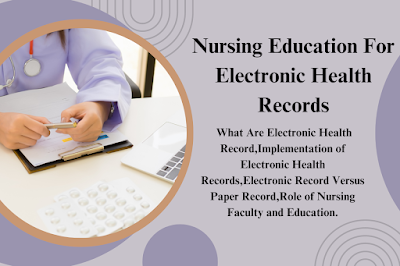Nursing Education For Electronic Health Records What Are Electronic Health Records?
Electronic Health Records (EHRs) are digital versions of patients’ health records, replacing the traditional paper-based records. Historically, nursing students learned documentation skills by manually recording patient information under the supervision of clinical faculty (Baillie, Chadwick, Mann, & Brooke-Read, 2013). The shift to electronic health records in the United States was mandated by the Health Information Technology for Economic and Clinical Health (HITECH) Act of 2009, which defines a qualified EHR as one that includes patient demographic and clinical health information, such as medical history and problem lists. It must also support clinical decision-making, physician order entry, and the exchange and integration of electronic health information from various sources.
The federal legislation aimed to have an EHR in use for every person in the United States by 2014. Nursing students must learn about various EHR systems, understanding their strengths and limitations in accessing essential information, communicating across disciplines and settings, coordinating care, and guiding patients through transitions in the healthcare experience (Mahon, Nickitas, & Nokes, 2010). Some nursing education programs have adopted academic EHRs that mimic real-world EHR systems and include educational components for assessing students’ documentation and providing feedback in an electronic format (Hanson, 2013).
Implementation of Electronic Health Records
The implementation of EHRs in healthcare involves a variety of systems developed and marketed by different vendors. Nursing students encounter different EHR systems as they rotate through various clinical sites during their training, but several barriers can impact their ability to document using the clinical agency’s EHR. Instead of providing simulated settings where students can experience and learn from mistakes, many students face a variable learning curve in real patient care environments, where their EHR education is directed by faculty with differing levels of expertise (Milano, Hardman, Plesiu, Rdesinski, & Biagioli, 2014).
To address the need for electronic documentation skills, educators have integrated academic EHRs into simulation experiences that encourage critical thinking while allowing for errors. Vendors offering academic EHRs include SimChart by Elsevier, Neehr Perfect, and Cerner’s Academic Education Solution (AES). Borycki, Joe, Armstrong, Bellwood, and Campbell (2011) developed an open-source system called the University of Victoria Interdisciplinary Electronic Health Record Educational Portal, which provides access to multiple EHR systems for health professional students.
Various strategies have been employed to implement EHRs in nursing education. For example, Anest (2013) described teaching pre-licensure nursing students medication administration using barcode technology, while interprofessional students used the MEDITECH software to simulate medication administration and documentation (Kirwin, DiVall, Guerra, & Brown, 2013). Meyer, Sternberger, and Toscos (2011) reported on experiences using Cerner’s AES. To mitigate the costs associated with purchasing an EHR system, Rubbelke, Keenan, and Haycraft (2014) used Google Drive, a free cloud storage solution, for storing documents. Another approach involves partnering with the EHR system used in clinical settings to provide students with practice on the same system they will encounter in their placements.
Electronic Record Versus Paper Record
The shift from paper-based records to EHRs is a global trend. EHRs offer several advantages, including improved care coordination, continuous access to up-to-date evidence, information exchange between providers, and enhanced patient engagement in their health and self-care (Topaz, Rao, Creber, & Bowles, 2013). However, the adoption of EHRs comes with costs, including an estimated expense of $35 to $49 per semester for each student using an academic EHR (Rubbelke, Keenan, & Haycraft, 2014). In addition, nursing faculty must develop proficiency in using EHRs and effectively teach these skills to students, who are often new to clinical practice.
Role of Nursing Faculty and Education
Nursing faculty play a crucial role in helping students develop competence in EHR documentation skills. They must establish clear systems for authorized access so that students can practice documentation during clinical placements (Baillie et al., 2013). Health professional educational programs should collaborate in selecting academic EHR systems and developing curriculum modules that teach both documentation skills and the importance of communication among healthcare team members.
Faculty members must ensure that students understand how to use EHRs effectively, including entering accurate and comprehensive data, using decision-support tools, and maintaining patient confidentiality. This training not only prepares students for real-world practice but also fosters a culture of safety and accountability in patient care.
Conclusion
Electronic Health Records (EHRs) are a transformative element in healthcare, reshaping how information is documented, shared, and utilized across different settings. For nursing education, incorporating EHRs into the curriculum is essential for preparing future nurses to navigate the complexities of modern healthcare environments. By developing skills in electronic documentation, nursing students become adept at using technology to enhance patient care, support clinical decision-making, and facilitate communication within interdisciplinary teams.
Nursing faculty play a critical role in this educational process, guiding students in developing the necessary competencies for EHR use. As the healthcare landscape continues to evolve, the integration of EHR training in nursing programs ensures that graduates are equipped with the digital literacy skills required to provide high-quality care and improve patient outcomes.
